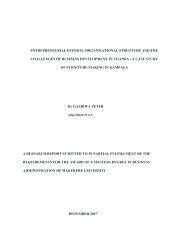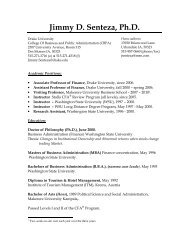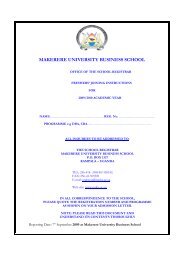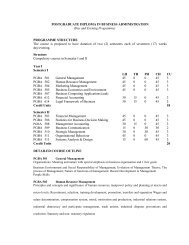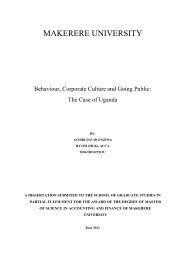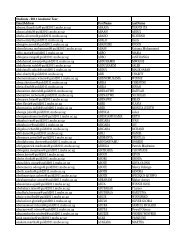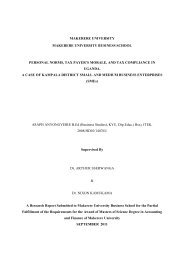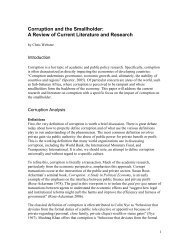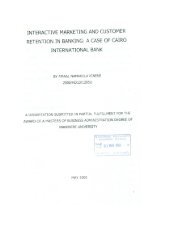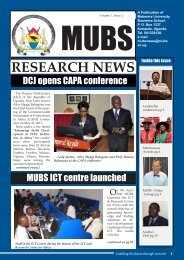13th Annual International Management Conference Proceeding
13th Annual International Management Conference Proceeding
13th Annual International Management Conference Proceeding
Create successful ePaper yourself
Turn your PDF publications into a flip-book with our unique Google optimized e-Paper software.
and food processing, reinvestments, networking, access to new markets, action planning and record keeping. Most<br />
outstanding was the business-like approach to farming and adoption to farming by Maasais who are traditionally<br />
pastoralists.<br />
All participants experienced increased income/profits ranging from 20% to 60% and better living standards.<br />
However, most changes were noted among the Kikuyus than was the case with Maasais. This was both in intensity and<br />
variety, and performance. Whereas average performance improvement was 40% among Kikuyus in both provinces,<br />
performance improvement among Maasais was an average of 25%. Among the Kikuyus, 30% of the participants had<br />
installed solar power, which they used for lighting, as well as powering their electronic gadgets. The study revealed an<br />
improved standard of living across participants in the two provinces: they ate quality and variety foods, were able to<br />
dress better, take their children to school, cater for extended family members and engaged in socio-economic<br />
development activities which involved contributing to community’s development activities such as churches and<br />
schools.<br />
Most striking was the zeal with which the Narok District participants had taken to crop farming as a major activity as<br />
opposed to their cultural animal rearing practice. These farmers were found to be trendsetters as some other members<br />
of the community were beginning to embrace crop farming too. This is a clear demonstration of what the training can<br />
do in changing attitudes to long held unproductive cultural beliefs and practices. For instance, due to the training, one<br />
of the participants foresaw approaching drought and sold his animals to avoid loosing them during the dry spell<br />
despite the great opposition from his father. He indicated that he had banked all the money to restock when the<br />
weather was more conducive, an indication of pro-activeness and the ability to make informed decisions. Another<br />
participant was under pressure to marry another wife because he had become wealthy according to Maasai standards,<br />
but he could not give in to the pressure. Instead, he had opened a savings bank account for future expansion and<br />
school fees for his children.<br />
The study also revealed that the participants were able to determine the performance of their entrepreneurial activities<br />
from proper records, which they kept. Before the training, they never kept any meaningful records of the expenditures<br />
and incomes and therefore, could not know when they were making profits or losses. Further, they had some form of<br />
action plans, which they used to guide their entrepreneurial activities and they were found to have adhered to them.<br />
This is an indication of good management practices at work.<br />
A number of personal and environmental factors were found to have influenced the application of the KSAs acquired.<br />
They included long draught especially in Rift Valley Province, which was worst hit, with most respondents especially<br />
in Narok District experiencing serious animal feed shortage, which led to family separation, with some taking the<br />
animals to distant lands in search of pasture, while others lost their livestock to the drought. Marketing of farm<br />
produce was another challenge the participants encountered as they lacked the ability to market their produce directly<br />
to the end user and therefore, had to use middlemen despite being aware of their exploitative tendencies. This was<br />
made worse by the huge transportation costs as well as the poor road infrastructure, especially in Narok District, where<br />
people walked long distances, as far as fifty (50) kilometres to reach the nearest market. The researchers too had this<br />
same experience: while conducting the study in the district, they had to drive through the jungle and undefined roads<br />
to reach the respondents. Inadequate credit access and availability also affected effective application of the KSAs<br />
acquired. However, on the contrary, the study revealed that most participants used community micro-finance<br />
programmes and reinvesting of profits as major financing strategies. Whereas the training may not have had credit<br />
linkage, it had enhanced the trainees’ capacity to source for investment credit because they were more confident and<br />
focused in what they were doing.<br />
Variations in the levels of entrepreneurial behaviour manifested themselves in the entrepreneurial and management<br />
practices among respondents from the two provinces. One major reason explains this: in Kenya, Kikuyus are known to<br />
be hardworking and successful business people with many role models unlike the Maasais. This was true to the study.<br />
The Kikuyus were more organized and practiced modern business management practices such as keeping proper<br />
records, action planning, new and improved varieties in farming, diversified business activities such as merchandising,<br />
sub-contracting, networking, working in groups, direct marketing, pro-activeness and focus on business growth, all<br />
practiced to a very limited scale among Maasais.<br />
97



